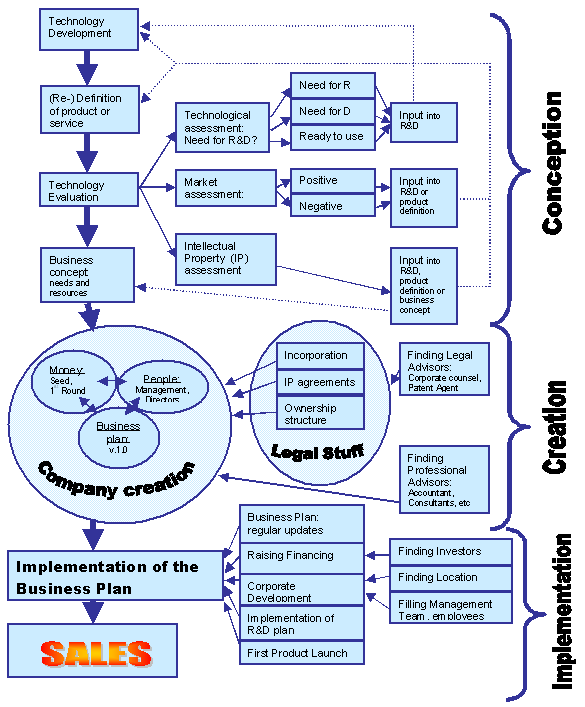Process of Forming a Company
From Concept to Sales - An Overview
Planning
Components of the Business Plan
Spin-off Company Development at the University of Alberta
Your Relationship with the University of Alberta
The University/Spin-off Relationship Agreement
Independent Spin-off Company Creation
Spin-off Company Development - Program Guidelines
This 15-question survey will help you identify areas of missing skills or knowledge, and areas where external help will be necessary. There are no absolute right or wrong answers. However, these questions may help you determine if the time is right or wrong to proceed with a start-up company. Please print off and complete this survey. Discuss these questions and answers with your RSO Technology Transfer resource contact.
You are encouraged to complete this survey again in one year and review and update it on an annual basis.
Open Survey 
 |
| Discuss these questions and answers with your Technology Transfer resource contact. |
|
The following is an additional resource that you should review as you contemplate if you should start-up a spin-off company:
| From Concept To Sales – An Overview |
|
The diagram below represents the start-up development process at a glance. The complexity of the diagram reflects the long, challenging, multi-directional, and frequently unclear nature of the start-up process. At the same time, this somewhat linear depiction of an inherently non-linear process provides a useful view of the preferred sequence of development. However, always remember that your path to success will likely involve multiple advances and retreats as you work to "get it right."
Notes:
Bold arrows connect the main “milestones” a company must pass through.
Thin arrows connect typical issues that are dealt with along the main path.
Dotted arrows represent possible connections that return to the main “milestones” of progress.
Use this diagram to place the module sections into the context of the company development process. |

Figure 1. Start-Up Development Process
|
 |
| In creating the company's vision, business concept and business plan, remember that commercial success is measured in a company's ability to generate money, i.e. sales. All decisions along the way must be made taking this into account. |
|
As previously noted, the commercial success of a company is measured by its ability to generate revenue, i.e. sales. Therefore, the company's vision statement, the business concept, the business plan – every corporate decision – should work towards this goal.
Although the need for thorough business planning seems obvious, it is surprising how many would-be entrepreneurs believe their situations are so different from others that no business plan format will fit their venture.
 |
| There is no rational justification for any company to not have a business plan. |
|
There are several types of important planning documents. Many become components of the overall business plan, and all require regular updates and revisions.
 |
BUSINESS PLAN TIPS |
Disclose all data sources.
Use professional help.
Keep your business plan up-to-date.
Date the business plan.
Track distribution (number copies).
Prominently display contact information.
Remember, the best time to raise capital is when you don't need it. |
|
Essential Business Planning Documents:
-
Short-term plan and Budget (1-year horizon)
-
Long-term Strategic Plan (five-year horizon and longer)
-
Vision, Mission and future developments documents
-
Financial statements: monthly budget, and annual financial projections over a rolling five-year period.
-
The Business Plan (For more details see Components of a Business Plan in the next section).
| Components of the Business Plan |
|
While the new venture business plan is written primarily to attract investors, it is also a communication tool for other stakeholders such as management, employees, directors and suppliers.
 |
| Organizations of all types and sizes use their business plans to clarify company objectives and chart strategies to attain them. |
|
 |
| Ideally, the business plan should be written by the person responsible for its implementation. |
|
This is a rough guide for size and content of important sections to the business plan:
Executive Summary (1 page)
Business Opportunity (half page to 1 page)
- The Technology and Technology Transfer Mechanism
- The Company: vision, mission, location, name, size, etc.
Product/Services
- Description
- Value Proposition
- Development Stage and Plans
Industry Analysis
- General information
- Size and Growth
- Trends
- Competitive Landscape and Risks
|
 (1 to 2 pages) (1 to 2 pages)
|
Marketing Plan (5 to 6 pages)
- Customers
- Company and Product Marketing Plans
Management Team (and Board of Directors) (1 to 2 pages)
Investment And Payback (1 to 2 pages)
Pro-Forma Financial Projections And Financial Statements (4 to 5 pages)
- Monthly for Year 1
- Annually for Years 2-5
| Spin-off Company Development at the University of Alberta |
|
The creation of a spin-off company is just one method for technology commercialization. The Research Services Office can assist you in determining the appropriate avenue for your technology – licensing or spin-off creation. If the Spin-off route is identified, key issues include:
Overview of Spin-off Formation
- The University of Alberta Patent Policy requires that all inventions and discoveries with 'patent possibilities' must be reported, via a Report of Invention Form (.doc).
- Contact Research Services for advice and assistance from the Technology Transfer Team. They will help you decide when to disclose and how to proceed.
- Complete the Report of Invention Form (.doc) and forward to Research Services:
- Provide full description of invention
- Provide full list of inventors & affiliations plus sources of funding for research
- Obtain required signatures from Chair and Dean
- Inventor(s) can either assign invention to the University or proceed independently (subject to any guidelines from funding source), as outlined on Page 19 of this Handbook.
- The University is assured 33.3% of any net income. This portion may take different forms. It is advisable to clarify the University claim on the technology before proceeding to investment.
- To avoid conflict of interest issues, inventors are required to sign a 'Relationship Agreement' that discloses and defines the relationship between the new company, the inventor(s) and the University. This agreement defines limits on use of University facilities, staff and students as well as transfer of other technologies/inventions.
- The company or inventor(s) must report yearly on commercialization activity.
|
A framework for creating a spin-off company and several companion documents and policies can be found on the Research Services web site at www.rso.ualberta.ca under the section called “Policies.” Additional information can be found at the TEC Edmonton Website at: http://www.uofaweb.ualberta.ca/
tecedmonton/
Useful documents include:
Technology Enterprises Works for You
One of the benefits of creating a spin-off company through the University is the access to a dedicated support program – Spin-off Company Development – provided by Research Services. This program operates under a Charter that defines the types of support available to companies and the conditions that determine access to this help.
| Your Relationship With the University of Alberta |
|
The University is a part of your company creation environment. Recognizing this fact and properly addressing all the relevant issues in a timely and professional manner is important for the success of your company. For all inventors/company founders there is a need to negotiate a formal relationship/agreement with the University.
Why is a formal relationship/agreement necessary?
-
The University has an obligation to maintain the integrity of academic research and teaching. That is why there are certain restrictions on the use of academic space, facilities, students and researcher's time in anything related to your commercial activity.
-
The University has an obligation to represent the interests of the public in the economic returns on publicly funded research undertaken at a publicly funded institution. That is why the University must negotiate a fair share of the returns from the technology commercialization.
Negotiating with the University
- Do not start negotiations until you know exactly what will be involved. You will save time, money and a lot of frustration.
 |
| Learn about negotiating in general. There are excellent books (e.g. Fisher and Ury, "Getting to Yes" ) and courses offered. |
|
What if the negotiations are stalled or if you do not want to negotiate?
-
The Patent Policy states: “any consideration (Net Income) other than cash must be valued by agreement with the University and the Inventor, failing which the value will be determined by arbitration.” To achieve this agreement the University will recommend a 3-month timeframe for negotiating the value.
-
If agreement on the value is not determined within a 3-month timeframe, the University has the right to impose a binding arbitration process.
-
If agreement is not met or there is no reasonable expectation that they will be met, the University will not open any new research accounts for any research related to the commercial activity. Issues of conflict of interest and proper use of public money and facilities must be properly resolved.
-
Inability to reach agreement with the University will ultimately halt your company's progress: investors will not invest, related research will be stalled, and resources and time will be wasted on the negotiation (or lack of it) until this is resolved.

Negotiating Tips
- Learn the “landscape:”
- What agreements are you negotiating and why?
- What are the rules (legalities)?
- Who you are negotiating with?
- What are your motives?
- Understand private-public boundaries and the essence of conflict of interest.
- Use the help of the Spin-off Company Development team to educate you about the landscape. This team does not represent the University interest or negotiate for the University. The Researchers and Technology Transfer Team are both clients of the Spin-off Company Development team.
- Access legal advice after you know what deal you want. The lawyer's job is to make sure that you are actually getting the deal you want.
- Do not make your lawyer negotiate for you: Firstly, if you do not know what deal you want, how can you expect somebody else to know? You may get something very different or unworkable. Secondly, you will be paying for the lawyer's time while learning what you want.
|
| The University/Spin-off Relationship Agreement |
|
Regardless of whether a spin-off company is created with the assistance of the Research Services Technology Transfer Team (assigned to the University) or independently, a Relationship Agreement between the spin-off and the University must be signed. This Agreement defines the framework for managing the inherent conflict of interest created when University and private commercial interests intersect. This Agreement also regulates the interactions between the University of Alberta, the spin-off company and the researchers involved.
Key Principles in Managing the Relationship
Basic Assumptions
It is assumed that when an inventor is also a principal in a new company, the inventor will be fully compensated for the inventor's share in the technology through founders equity in the new company. Hence, the inventor is expected to waive all rights to a share in the University's portion of the income from the technology. The inventor may also obtain further compensation in terms of additional equity for future involvement in management and/or initial financial support to the company. However, this additional compensation is separate from the compensation for the technology. The inventor is encouraged and expected to seek separate legal, tax and accounting advice on the arrangement of their financial agreement with the company.
Need for Full Disclosure
To manage the potential for, and a perception of, any conflict of interest for the inventor, the inventor is required to provide full disclosure, in writing to their Dean and the Director of the RSO, of the financial relationship between the inventor and the new company. This ensures a full understanding of the financial relationships between the inventor, the company and the University.
Relationship Agreement
To manage any potential future conflicts of interests or perceptions of conflicts of interests, the inventor, the company and the University are required to sign a Relationship Agreement (.pdf). The Relationship Agreement contains clauses on the following key principles:
- Separation of corporate and University activities, (except under a signed University research contract).
- Restrictions on the use of University facilities, students and staff.
- Disclosure and management of all future IP developed by the inventor while at the University.
- Acknowledgment and compliance with all University policies and regulations.
- Audit of company financial statements, if needed.
- No use of University name.
- No warranty by University.
- Mutual indemnity.
Responsibilities of the University
The purpose of the Relationship Agreement is also to uphold the responsibilities of the University as a public institution funded by the taxpayers. Restrictions on use of University facilities, students and staff by the spin-off are particularly important to ensure that the University is not perceived to be subsidizing a particular company in which it may have a financial interest. When an inventor is a principal in the company, it is expected that the inventor will report and assign to the University any new IP developed by the inventor which is either sponsored by the company or in which the company has an interest. By managing the licensing of such new IP to the company, the University ensures that the University, and therefore the public, receives the appropriate financial share from commercialization of such IP.
In the process of discussing the Relationship Agreement, the inventor(s) is also encouraged to develop independent management expertise and to optimize efficient communication to minimize any bureaucratization of the relationship.
The goal is the creation of a commercially viable entity and to ensure a fair return to the inventor(s), the University (on behalf of the public) and any investors.
Please see a template for a Relationship Agreement 
| Independent Spin-off Company Creation |
|
When a new company is started through assignment of technology to the UofA and therefore the assistance of the RSO's Technology Transfer group, you will be guided through the process in accordance with University Guidelines. However, if a new spin-off is created independently from the University (this is allowed under the University policies) a number of additional issues have to be addressed.
Basic Principles of University Entitlement
The definition of a University spin-off company is a new company that has been established around a University technology or group of technologies. When a University spin-off company is first incorporated, its only asset is the technology (intellectual property) developed at the University. Typically, significant amounts of public funds were spent during the development of the technology in the form of research grants, salaries and University infrastructure support. It is also likely that the new company will pursue other public funds to assist in the continued commercialization. As a public institution, the University is entitled to receive a portion of any revenue from commercialization of this technology in compensation for past and ongoing support. This portion is an acknowledgment of the public interest in the technology and the role of the University in representing the interests of the Canadian public.
Revenue Distribution
The Patent Policy at the University of Alberta states that the University's portion in the case of independent commercialization is 1/3 of any 'net revenue'. In the case of a simple license to an independent third party, this would represent 1/3 of any net revenue paid to the inventor. The policy clearly defines 'net revenue' in this case. In the case of a new spin-off company, where the inventor is a major initial shareholder in the new company, the interpretation of the 1/3 net revenue is somewhat more complex. Typically, when a new spin-off company is formed the inventor is the sole owner of the company and the only asset in the company, at the time of formation, is the technology, which is transferred into the company. In this case, the University is entitled to 1/3 of the company (i.e. 33.3% equity).
However, depending on the business plan and nature of the technology, the University may accept a combination of a reduced equity combined with a royalty arrangement to capture the 1/3 interest. The University also recognizes the need to ensure that the inventor (and majority owner) of the new company has both the incentive and the financial flexibility to make the company grow and succeed, and ultimately allow the technology to benefit Canadians. Hence, the University is flexible in accepting a range of positions to capture the public interest in this new venture and allow the company to grow and succeed.
It is also important to keep in mind that the respective Faculty is also a stakeholder in the University interest in the technology, hence, any agreement between the University, the inventor and new spin-off company requires the approval from the Dean of the respective Faculty.
The University is typically reluctant to hold equity in a private spin-off company that has a major business focus in the service area with no intention of going public or being acquired by a larger public company. In this case the University usually accepts a simple royalty arrangement.
For a spin-off company that has an aggressive business plan to expand and go public relatively quickly, the University may accept a straight equity position with no royalty. For most companies where the business plan is less clear, the University generally prefers a mixed equity and royalty position to reflect the 1/3 interest. The University is flexible in its application of the Patent Policy and typically accepts between 10% to 30% pre-dilution equity plus some royalty on sales and a reasonable flow-through on sublicense fees. This position can be re-negotiated as the company grows and the business plan changes. The University equity position is fully dilutable on an equal basis with other shareholders when future third party equity investments are made into the company.
Conflict of Interest
In the independent route, the direct transfer of the technology into a new spin-off company puts the inventor in a conflict of interest. This is because the inventor has conflicting roles as owner of the technology and owner of the new company and the inventor must also protect the interests of the University in the technology. To ensure that the University interest is fairly represented and to manage the conflict of interest, the inventor is required to sign a Relationship Agreement, which defines the relationship between the inventor, the new company and the University.
The Relationship Agreement should also include sections that define the interest (equity and/or royalty, etc.) of the University in the new spin-off company and the rights for all possible future university technologies from the inventor. The Relationship Agreement creates a framework for managing current and future conflict of interest and allows for continued research at the University in the area of the technology that can benefit the company. In the absence of such agreement the University and Faculty would not allow research in the area of the technology to be performed using University facilities.
External Relationships
Potential investors in new spin-off companies prefer a clear, well-defined linkage between the technology, the company and the University. A well-defined linkage with the University is generally a major asset to a new company in building credibility in the business community. Experience throughout North America has shown that numerous spin-off companies have grown successfully with a clear, well-defined University partnership.
Technology Ownership
Almost all major North American universities operate in a similar manner when dealing with new spin-off companies. The only differences relate to different policies on ownership and revenue distribution. A recent survey of major North American universities showed the following:
- At almost all U.S. universities and at approximately 50% of Canadian universities, the university owns the technology and commercialization must be carried out through the university.
- At most major North American universities the revenue distribution averages around 30% to the inventor.
- Most universities take a mixture of equity and royalty in new spin-off companies and some request non-dilution clauses on the university portion of equity.
At the University of Alberta, the inventor owns the technology and has the freedom to pursue commercialization independently. The inventor retains 66.6% of net revenues, if commercialization is pursued independently.
Lower Success Rates for Independents
University of Alberta statistics show that very few (less than 5%) technologies are successfully commercialized independently, whereas, 50% of the technologies accepted by the University are successfully commercialized. These numbers are typical for major North American universities that have a dedicated office for technology commercialization and that allow inventors the choice to pursue commercialization independently.
| Spin-off Company Development |
|
Program Guidelines
Mission
The Spin-off Company Development team, University of Alberta, a part of Research Services Office (RSO), assists the University's early stage companies to acquire the tools necessary to become successful businesses.
Program Description: A Spin-off company development program.
Primary Customers
The primary customers of the team are the stakeholders of the technologies, which provide the basis for new company formation:
the University researchers, creators of the technologies
the University of Alberta, which is represented by Technology Transfer Teams responsible for Intellectual Property (IP) management (patenting, licensing, etc.)
other owners of the technologies who acquired their ownership through either collaborative research with the University researchers or through their support of the research
Founders
When the decision for company formation is made, the stakeholders become founders of the company together with any partners who became involved in this process. After the company is created and a formal agreement with the Spin-off Company Development team is reached, the Founders become the team's customers.
Roles
The Spin-off Company Development team seeks to establish collaborative working relationships with other founders of the University's startups. The team striving to create an effective and efficient team for each project. The roles in and commitments in each startup may vary depending on the team members' skills, attitudes and other commitments. It is important to identify the extent of each party's involvement in quantitative and measurable terms early in the project.
The team's objective is to compliment the missing skills and time commitments in the project team. The team will focus on the business side of company development and will rely on the resources of the team and other resources of the RSO. At the same time the team will rely heavily on the technical and scientific expertise of the researchers participating in the project.
When Technology Enterprises team get involved
The team gets involved with early stage University of Alberta spin-offs in the following typical situations:
- Concept: work with very early stage companies or company concepts that are not yet sufficiently developed to be accepted by both the local and regional technology community or venture capitalists;
- Creation: if the researcher is not interested in leaving the University and running the company, the team may champion company formation in collaboration with the Technology Transfer Team;
- Development: work with companies that require very early stage business development: product prototyping, market research and marketing, business promotion, etc;
- Packaging: companies that require "packaging" for acceptance by first round investors and industry.
- General start-up and business related advice: The team also provides general start-up and business related advice to the University researchers and administration on ad hoc basis. In particular, the team may serve as a sounding board and advisor to those researchers who either are involved with technology companies or are thinking about starting one.

Resolve IP Issue
In order to qualify for assistance the company must satisfactorily resolve any IP and equity ownership issues with the University and other owners. This includes assigning the technology to the University, determining a licensing arrangement and signing of the Relationship Agreement with the University. |
Relationship with the University's Technology Transfer Teams
The RSO Technology Transfer Teams at the University of Alberta play an important role in the Technology Commercialization process. There are two aspects of their mandate that are most relevant to the University spin-off companies.
First, the Technology Transfer Teams represent the University's interest regarding any IP developed at the University of Alberta . Therefore each new spin-off company has to negotiate with the Technology Transfer Team all legal agreements regulating transferring IP from the University or determining the University's interest in the venture. The Technology Enterprises team may assist the company by educating the principals of the company about technology valuation, IP management and licensing but it does not represent the University in negotiations.
Second, the Technology Transfer Teams manage IP for the technologies assigned to the University, which involves evaluation, protection and licensing. Since IP management is a highly complex and specialized field, a start-up can greatly benefit from the professional management of the patent process and licensing arrangements provided by Technology Transfer Team. It is important to establish and maintain a collaborative working relationship with your Technology Transfer Team.
Spin-Off Company Development Agreement
After a thorough evaluation of the project, when the potential for the Technology Enterprises team involvement is identified, a formal project agreement (Relationship Agreement (.pdf)) has to be negotiated and executed. This Agreement shall describe the goals of the project, including timelines, deliverables and milestones. The Agreement will define roles and commitments of the founders, including the assistance from the Technology Enterprises team. The Agreement will also determine the ownership positions in the company pending achievement of the deliverables.
Technology Enterprises Team Assistance
Early stage company development entails a number of quite generic activities, which must be performed by the founders. Some of the activities may be performed by the researchers alone or done with their participation. Others require specialized business skills and will require additional expertise. The Technology Enterprises team can provide assistance in all of the activities or only a select few. Typical activities where the team can provide assistance include:
- information on the local technology commercialization, innovation and support infrastructure;
- business concept development, market research, business planning;
- assembling Board of Directors and management team;
- promotion of the startup company;
- organizing and streamlining the business development process;
- developing an initial budget and raising the “pre-seed” financing;
- connecting to business infrastructure: identifying lawyers, accountants and consultants, identifying and approaching investors, etc.
- training management personnel for the companies, through formal training and internship placements, in cooperation with Alberta School of Business, University of Alberta;
The assistance is provided in a collaborative fashion with “buy-in” and possible involvement of all stakeholders of the technology. The amount and extent of the assistance will vary from one startup to another and may be affected by the ownership positions in the company, commitment, involvement and contribution of all stakeholders of the technology.
Goal
A typical Spin-off Company Development project achieves its goal when a company has three essential components in place:
Viable business plan, as determined by comprehensive market research and ability of the business plan to attract a management team and financing
Core management team, who participates in business plan development and is capable of its execution
Financing, typically sufficient to take the company to its next stage of development and financing
Depending on the particular business situation the goals may be formulated differently.
Back to Top
| 
















